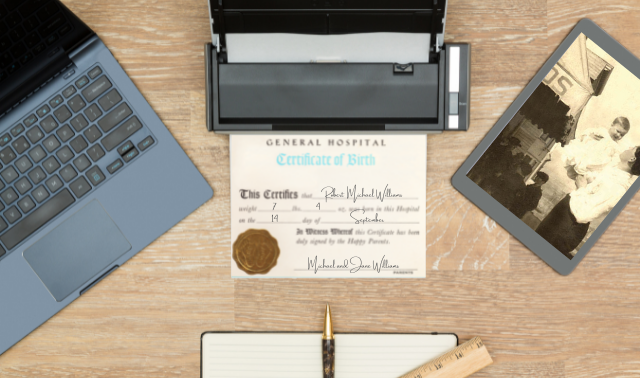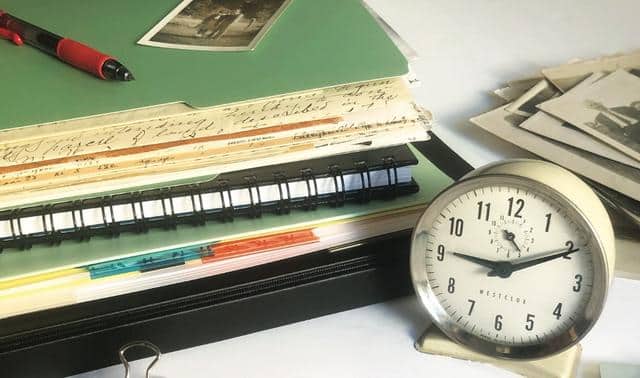Sign up for the Family Tree Newsletter Plus, you’ll receive our 10 Essential Genealogy Research Forms PDF as a special thank you!
Get Your Free Genealogy Forms
"*" indicates required fields
We genealogists spend most of our time digging into the past. But, at some point, it’s a good idea for us to turn around and look into the future of those well-documented family trees and heirlooms.
Modern estate-planning professionals offer guidance for passing on our homes and financial assets to the next generation. Sadly, family treasures and genealogy research are often omitted from any formal bequest.
Without a legacy plan, your carefully documented family tree may wither and die. And the boxes of old photos and documents you’ve spent a lifetime curating could be shipped off to an antiques dealer. The old adage “You can’t take it with you” mocks every researcher without a plan for the future of their genealogy life work.
Begin planning for the future of your genealogy by creating your own “genealogical will” or genealogy codicil. Such a document doesn’t need to be complicated, nor is it expensive to make. Another option is including language in your existing will—you do have a will, right?—that grants authority over digital assets. The right details in any of the aforementioned allow your representative to access email, Facebook, etc., should it be necessary.
If you’ve inherited a family home or estate, you can understand the challenge of trying to honor a loved one’s wishes. Your family and heirs will appreciate your thoughtfulness in taking time to share yours. And you’ll rest assured that your digital life will be respectfully handled after you’re gone.
This guide will show you how to create a genealogy will or codicil: how to organize your materials, and what items and accounts to include in it.
What is a Codicil?
A will is straightforward-enough to understand. But what’s a codicil? A codicil to a last will and testament is an amendment or addition to the document, says California trusts and estates attorney Scott T. Holman. Like a will, a codicil should be witnessed by two disinterested parties. Holman recommends having the document prepared by an attorney to ensure its validity so your last wishes are fulfilled as you intended.
Step 1: Organize Your Research
Our ancestors’ estate typically included land, houses, livestock, crops, money and household goods. By contrast, a 21st-century estate usually focuses on real estate and financial assets. Unfortunately, family photos, documents and artifacts are grouped with “personal property” and given little individual attention. And “digital assets” are often overlooked entirely.
Be proactive by referencing specific genealogical items in your legacy-planning, and think of them as individual assets to mention in your will. Among your collection might be
- raw information (data)
- written reports and documents
- family photos and papers
- genealogy books or histories
- technology tools
Consider, too, where these materials are stored. (How else will people know where to find them?)
Make a list in the form of an asset inventory, perhaps in a spreadsheet or a word-processor. Include physical materials (keepsakes, family trees, original documents) that you’d like to pass on to others, as well as digital accounts you’d like to share or have closed when you pass away.
Step 2: Consider Physical Genealogy Assets
If you’ve been researching for more than a few years, you probably own research books and family history paperwork, in addition to family photos and heirlooms. It’s not necessary to list every title on your bookshelves (unless you have some special bequests). But do give your heirs some ideas if you’d like your materials passed on to your local genealogy society or research buddy, and indicate where to look for the different pieces of your collection.
Your physical genealogy assets include those family treasures that you’ve inherited, as well as those from your own lifetime. Here’s a thorough (though not totally comprehensive) list of items you may want to include in your asset inventory:
- Reference books
- Published genealogies
- Files, including family trees and records ordered from archives
- Research notes
- Computer and/or laptop and hard drives
- Scanners, digital cameras and accessories
- Family photos and albums
- Family diaries, letters and journals
- Special family collections
- Handmade items (quilts, tablecloths carvings)
- Lineage society memorabilia
- Scouting or club memorabilia
- Business photos and artifacts
- Jewelry, watches and rings
- Furniture
- Artwork
- Military medals and uniforms
- Antiques
Be sure to include the present location of each item, its significance, and any special bequests. Note the most important materials that you’d like passed on to your heirs. Write down the story of the item’s place in your family history, and add photos or letters if you have them.
This is also the time to move items to archival storage containers if you haven’t already done so. Include a handwritten note to the recipient and label the box.
Use your codicil to let your family know where to donate your genealogy library or written family histories. You may need to do some homework to find a repository with interest and archive space to accommodate your materials. Don’t assume a library, museum, or society will be able to accept your legacy.
Step 3: Include Digital Genealogy Assets
In the past decade, the average genealogist’s digital footprint has grown faster than a toddler’s shoe size. Free research sites, trial smartphone apps, and cloud storage are available with just a few clicks and a username, email address or even Facebook account. Decades of research may be bound up in your Ancestry.com account, or squirreled away in a password-protected desktop software program.
But all these usernames and passwords have a long life expectancy—long enough to outlast even their owners. So you’ll want to be meticulous in including information about your digital assets in a genealogy will or codicil. Your next of kin (or your designated genealogy heir) will need access to your computer and online accounts.
The process for gaining access to another person’s online account varies, but it usually isn’t a simple matter of asking the company for Dad’s login. It may take time and a lot of paperwork, so leaving behind your username and password will save your survivors quite a bit of time and allow them to more easily log in to your account, download what’s necessary or delete information.
We often offer new genealogists the advice “Start at home.” This is a good first step for digital assets, as well: List all your active online subscription services, email accounts, and social media profiles. Start with software on your home computer and move on to online accounts.
For each digital asset, include:
- URL for account login (or login instructions)
- Username and password
- Instructions to delete: yes or no
- If no, how long to maintain
- Cost and how paid, including payment method
Digital businesses recognize that heirs may need access to the inactive accounts of a person who has passed away. Check the services you use to see if they offer options to set up a legacy contact or beneficiary.
Here are some special considerations for each of these common digital assets.
List each email account. This is a good time to go back and delete old email accounts that have become inactive. Keep things simple for yourself now (and for your heirs later) by maintaining only accounts that you need.
Personal Website
If you own a website and/or blog, include the domain name registry, blog hosting platform, website access, blog email, and any other maintenance providers. If you would like your heirs to maintain your online presence for a certain amount of time (for example, two years), remember to leave a monetary bequest to pay for the cost.
If your blog has become dormant, consider downloading a printable archive or blog-to-book printed book through a company such as Blurb.
Subscription and Backup Software
In the past decade, software access has moved steadily from one-time purchases to ongoing subscriptions. List all paid subscription general services such as Office 365, Adobe Cloud and Evernote. And while you’re still living, review the list to cancel any services you no longer need.
Add access information for backup services, especially, such as Dropbox, Carbonite, etc. These data sites are likely to hold genealogical databases, written reports, images and other crucial files.
Your next of kin will have difficulty getting into a secure account, such as your Dropbox account, if you don’t provide adequate information. Though they could simply check to see if your desktop is set up to link to a Dropbox account, they may need to contact Dropbox directly using information like your name, email address, and mailing address, plus their relationship to you (the deceased) and a copy of their government ID. Failing that, they’d need a court order that specifies you intended for them to have access to their files.
Because of how versatile it is, Google is worth mentioning separately. The search engine giant suggests users set up the Inactive Account Manager while they’re able to. This feature allows users to share account features with others, as well as to notify a designated contact if the user has been inactive for a certain period of time. For example, you could designate your next of kin to have access to your mail, blog, Google Drive , etc., only after you’ve been inactive for six months.
To do so, log in to Google and click Manage Your Account, then Data and Privacy > More Options > Make a plan for your digital legacy. (Or simply go to your Google Account and search for Inactive Account Manager.) Step-by-step instructions will guide you to name a trusted contact who’ll be notified by email when the account has reached the designated time of inactivity in Google apps such as Gmail , Google Search, and YouTube. Google will send you emails and even text messages before it contacts your next of kin after a period of inactivity, so you don’t need to worry about a false alarm.
Research and DNA Sites
Here’s how you can be a considerate bequeather if you have accounts at the following popular genealogy websites:
- Ancestry.com: A Support page lists specific requirements for next of kin wanting to access or request deletion of a deceased user’s account.
- FamilySearch: Accounts of deceased users at FamilySearch are disabled, and surviving family members cannot inherit or gain access to the account. Notify FamilySearch when your relative has passed away to have the account disabled. (Any information submitted to the Family Tree by a deceased user—as well as public-facing Memories—will remain on the site.)
- Family Tree DNA: DNA kits and accounts may be transferred to a named beneficiary when the account holder passes away. This person gains control of the account and can order further tests with any remaining DNA. Add beneficiary information to your online account and print a hard copy of your information by visiting your Contact Information page, then Beneficiary Information.
- MyHeritage: First-degree relatives such as a spouse, sibling, parent, or child may ask to take over a family site or delete the MyHeritage account of a relative who has passed away. See the MyHeritage FAQ for current requirements to gain access .
Another option is leaving behind your username and password to the above, and instructing your beneficiary to either delete these accounts or maintain them for a certain amount of time. That will prevent them from having to request control of your account through customer service, or from needing to be a named beneficiary.
Social Media Accounts
Social media accounts are a gold mine of personal information, from friends and family names to birthdates and lists of your favorite, well, everything—books, movies, TV shows, hobbies and more.
Check the legacy practices of each social media site where you hold an account. Some, like Twitter, simply delete accounts of users whose death has been confirmed, but others allow the user additional options. Be aware that privacy rules constantly change, and keep up-to-date on the current standards. For information, search a service’s help section for deceased or memorialization.
Many genealogists have made family connections and broken through brick walls using Facebook. Photos, shared files, and saved posts may hold memories you’d like to preserve. With this mind, Facebook profiles of the deceased can be memorialized—essentially, frozen in time. Users can designate a legacy contact who will administer their memorialized account when the time comes. The legacy contact can also download an archive of the user’s content if that feature is turned on.
Taking these proactive steps will help prevent your loved ones from the heartache and inconvenience of your account getting hacked after you’re gone. Scammers target the accounts of deceased users to send phishing messages or target ads.
Facebook’s partner service, Instagram, also memorializes the accounts of deceased users. The account will be locked against logins and content will remain posted. Confirmed family members can request that an Instagram account be removed by providing the proper documentation.
Creating a genealogy will or codicil (as well as a genealogy asset inventory) is a thoughtful legacy. Your heirs will be grateful that you planned ahead so they could respectfully honor your wishes.
A version of this article appeared in the January/February 2022 issue of Family Tree Magazine.
Related Reads
ADVERTISEMENT










